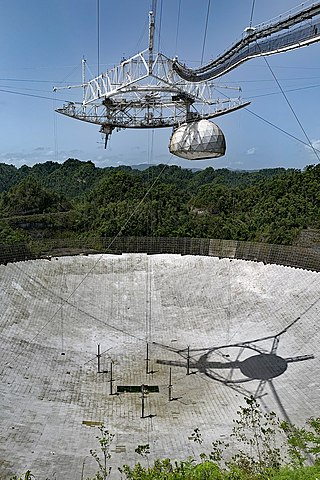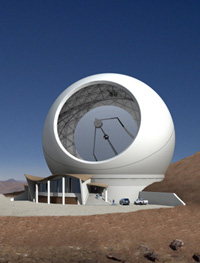
A radio telescope is a specialized antenna and radio receiver used to detect radio waves from astronomical radio sources in the sky. Radio telescopes are the main observing instrument used in radio astronomy, which studies the radio frequency portion of the electromagnetic spectrum emitted by astronomical objects, just as optical telescopes are the main observing instrument used in traditional optical astronomy which studies the light wave portion of the spectrum coming from astronomical objects. Unlike optical telescopes, radio telescopes can be used in the daytime as well as at night.

Frank Donald Drake was an American astrophysicist and astrobiologist.

Radio astronomy is a subfield of astronomy that studies celestial objects at radio frequencies. The first detection of radio waves from an astronomical object was in 1933, when Karl Jansky at Bell Telephone Laboratories reported radiation coming from the Milky Way. Subsequent observations have identified a number of different sources of radio emission. These include stars and galaxies, as well as entirely new classes of objects, such as radio galaxies, quasars, pulsars, and masers. The discovery of the cosmic microwave background radiation, regarded as evidence for the Big Bang theory, was made through radio astronomy.

Sandra Moore Faber is an American astrophysicist known for her research on the evolution of galaxies. She is the University Professor of Astronomy and Astrophysics at the University of California, Santa Cruz, and works at the Lick Observatory. She has made discoveries linking the brightness of galaxies to the speed of stars within them and was the co-discoverer of the Faber–Jackson relation. Faber was also instrumental in designing the Keck telescopes in Hawaii.

The Arecibo Observatory, also known as the National Astronomy and Ionosphere Center (NAIC) and formerly known as the Arecibo Ionosphere Observatory, is an observatory in Barrio Esperanza, Arecibo, Puerto Rico owned by the US National Science Foundation (NSF).

Vera Florence Cooper Rubin was an American astronomer who pioneered work on galaxy rotation rates. She uncovered the discrepancy between the predicted and observed angular motion of galaxies by studying galactic rotation curves. Identifying the galaxy rotation problem, her work provided the first evidence for the existence of dark matter. These results were confirmed over subsequent decades.
VIRGOHI21 is an extended region of neutral hydrogen (HI) in the Virgo cluster discovered in 2005. Analysis of its internal motion indicates that it may contain a large amount of dark matter, as much as a small galaxy. Since VIRGOHI21 apparently contains no stars, this would make it one of the first detected dark galaxies. Skeptics of this interpretation argue that VIRGOHI21 is simply a tidal tail of the nearby galaxy NGC 4254.
A dark galaxy is a hypothesized galaxy with no, or very few, stars. They received their name because they have no visible stars, but may be detectable if they contain significant amounts of gas. Astronomers have long theorized the existence of dark galaxies, but there are no confirmed examples to date. Dark galaxies are distinct from intergalactic gas clouds caused by galactic tidal interactions, since these gas clouds do not contain dark matter, so they do not technically qualify as galaxies. Distinguishing between intergalactic gas clouds and galaxies is difficult; most candidate dark galaxies turn out to be tidal gas clouds. The best candidate dark galaxies to date include HI1225+01, AGC229385, and numerous gas clouds detected in studies of quasars.

The Atacama Pathfinder Experiment (APEX) is a radio telescope 5,064 meters above sea level, at the Llano de Chajnantor Observatory in the Atacama desert in northern Chile, 50 km east of San Pedro de Atacama built and operated by 3 European research institutes. The main dish has a diameter of 12 m and consists of 264 aluminium panels with an average surface accuracy of 17 micrometres (rms). The telescope was officially inaugurated on September 25, 2005.

Llano de Chajnantor Observatory is the name for a group of astronomical observatories located at an altitude of over 4,800 m (15,700 ft) in the Atacama Desert of northern Chile. The site is in the Antofagasta Region approximately 50 kilometres (31 mi) east of the town of San Pedro de Atacama. The exceptionally arid climate of the area is inhospitable to humans, but creates an excellent location for millimeter, submillimeter, and mid-infrared astronomy. This is because water vapour absorbs and attenuates submillimetre radiation. Llano de Chajnantor is home to the largest and most expensive astronomical telescope project in the world, the Atacama Large Millimeter Array (ALMA). Llano de Chajnantor and the surrounding area has been designated as the Chajnantor Science Reserve by the government of Chile.

Associated Universities, Inc. (AUI) is a research management corporation that builds and operates facilities for the research community. AUI is a not-for-profit 501(c)(3) corporation, headquartered in Washington, DC. The President is Dr. Adam Cohen. AUI's major current operating unit is the National Radio Astronomy Observatory (NRAO), which it operates under a Cooperative Agreement with the National Science Foundation.

Jennifer J. Wiseman is Senior Project Scientist on the Hubble Space Telescope, and an American astronomer, born in Mountain Home, Arkansas. She earned a bachelor's degree in physics from MIT and a Ph.D. in Astronomy from Harvard University in 1995. Wiseman discovered periodic comet 114P/Wiseman-Skiff while working as an undergraduate search assistant in 1987. Wiseman is a senior astrophysicist at the NASA Goddard Space Flight Center, where she serves as the Senior Project Scientist for the Hubble Space Telescope. She previously headed the Laboratory for Exoplanets and Stellar Astrophysics. She studies star forming regions of our galaxy using radio, optical, and infrared telescopes, with a particular interest in molecular cloud cores, protostars, and outflows. She led a major study that mapped a star forming region in the constellation Orion.

The Arecibo Telescope was a 305 m (1,000 ft) spherical reflector radio telescope built into a natural sinkhole at the Arecibo Observatory located near Arecibo, Puerto Rico. A cable-mount steerable receiver and several radar transmitters for emitting signals were mounted 150 m (492 ft) above the dish. Completed in November 1963, the Arecibo Telescope was the world's largest single-aperture telescope for 53 years, until it was surpassed in July 2016 by the Five-hundred-meter Aperture Spherical Telescope (FAST) in Guizhou, China.
Gary Alan Wegner is an American astronomer, the endowed Leede '49 Professor of Physics and Astronomy at Dartmouth College, and recipient of the Alexander Von Humboldt Prize. Wegner was also a member of a famous group of seven astronomers called the Seven Samurai who, in the 1980s, discovered the location of the Great Attractor. He has co-authored and authored over 320 articles in astronomy and astrophysics.

The Astronomy and Astrophysics Decadal Survey is a review of astronomy and astrophysics literature produced approximately every ten years by the National Research Council of the National Academy of Sciences in the United States. The report surveys the current state of the field, identifies research priorities, and makes recommendations for the coming decade. The decadal survey represents the recommendations of the research community to governmental agencies on how to prioritize scientific funding within astronomy and astrophysics. The editing committee is informed by topical panels and subcommittees, dedicated conferences, and direct community input in the form of white papers summarizing the state of the art in each subdiscipline. The most recent report, Astro2020, was released in 2021.
Riccardo Giovanelli was an Italian-born American astronomer. He was an emeritus professor of astronomy at Cornell University in Ithaca, New York, United States.

The Cerro Chajnantor Atacama Telescope (CCAT) is a proposed 25 metres (82 ft) diameter telescope that is intended to reveal the cosmic origins of stars, planets, and galaxies with its submillimeter cameras and spectrometers enabled by superconducting detector arrays. The telescope was originally called the Cornell Caltech Atacama Telescope, but due to lack of funding the 25 metre telescope is currently on hold.
The Taurus Void is a vast, near-empty region of space situated between the Perseus–Pisces Supercluster and the Virgo Supercluster. The Taurus void is unique because of its relatively close proximity to Earth, and because it helps to define the edge of latter's home supercluster, the Virgo Supercluster. Despite its close proximity to Earth, the Taurus Void is not well-studied because it is partially obscured by the Milky Way when viewed from Earth. In contrast to its ambiguous boundary in the section of sky obscured by the Milky Way, the Taurus Void has a very well-defined boundary with the Perseus-Pisces supercluster.

Karen Masters is an Astrophysicist and Associate Professor of Astrophysics in Haverford College, Pennsylvania exploring galaxy formation. She is also the project scientist for the citizen science project Galaxy Zoo, and uses the classifications to study the evolution of galaxies.
Sabrina Stierwalt is an American extragalactic astrophysicist who studies gas dynamics and the formation and evolution of galaxies through surveys utilizing x-ray, ultraviolet, optical, infrared, submillimeter, and radio wavelengths. She is experienced in science communication and advocating for equality and equity for underrepresented groups in science, technology, engineering, and mathematics (STEM) fields.














